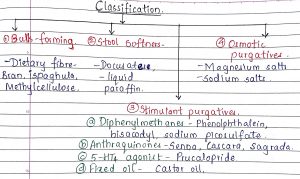These are the drugs which promote evacuation of bowels.
Laxatives :- milder action, elimates soft but formed stools.
Purgatives :- stronger action, more fluid evacuation.
Mechanism of action :
All purgatives increase the water content of faeces by :
- An osmotic action, retaining water & electrolytes in the intestinal lumen. This increases volume of stools & is easily propelled.
- Decrease net absorption of water & electrolytes in intestinal mucosa
- Increasing the propulsive activity. This allows less time for salt & electrolytes to be absorbed.
The mechanisms by which they obtain above actions are :
- Inhibiting Na -K- ATPase of villous cells – impairing electrolyte & water absorption.
- Stimulating adenylyl cyclase in crypt cells–increasing water & electrolyte secretion.
- Enhancing PG synthesis in mucosa– increases secretion.
- Increasing NO synthesis. Enhances secretion & inhibits non propulsive contractions in colon.
1. Bulk purgatives :-
- Dietary fibre – Bran :
-Bran absorbs water in the intestines , swells & increases water content of faeces – softens it.
-Osmotically active products are formed in colon, which tend to retain water.
-Bran supports bacterial growth –contribute to faecal mass.
-Useful when straining at stools has to be avoided.
-It is safe, but unpalatable.
-20-40 g/day needs to be ingested.
-It does not soften the faeces already present in the rectum.
-Bran is useful for prevention of constipation, but not for treating already constipated patients.
- Ispaghula –
-Contains natural colloidal mucilage which forms a gelatinous mass by absorbing water.
-Is largely fermented in colon – Increases bacterial mass, softens the faeces.
-Ispaghula husk is mixed (3-8 g) with cold milk, fruit juice or water.
-Should not be swallowed dry.
- Methyl cellulose.
2. Stool softeners :
- Docusates – It emulsifies the colonic contents & increases penetration of water into faeces.
- Liquid paraffin – Softens stools. Lubricates hard scybala by coating them. It is bland. Difficult to swallow. Carries away fat soluble vitamins with it. Deficiency may occur on chronic use.
3. Stimulant purgatives :
Mechanism of action –
- They inhibit NaK ATPase at the basolateral membrane of villous cells – transport of Na & accompanying water into interstitium is reduced.
- So there is accumulation of water & electrolytes which increase the bulk of faeces.
- Also , they increase intestinal motility by acting on myenteric plexuses.
4. Osmotic purgatives :
- Solutes that are not absorbed in intestine retain water osmotically & distend the bowel – increase peristalsis.
- All inorganic salts used here augment the motility & secretion .
- Saline purgatives are not used now for constipation because they produce watery stools after constipation. So are unpleasant.
- They are preferred for preparation of bowel before surgery & colonoscopy.
Indications of laxatives :-
- Functional constipation
- In Bedridden patients (To prevent constipation – give bulk forming agents, To treat constipation – Enema)
- To avoid straining at stools
- To prepare bowel for surgery, colonoscopy, abdominal X-ray.
- Food / drug poisoning.
Laxatives are contraindicated in :
- A patient of undiagnosed abdominal pain, colic or vomiting.
- Organic constipation due to strictures or obstruction, hypothyroidism, malignancies
- Certain drugs like sedatives, anticholinergic, clonidine, verapamil, antihistamines.
Contributed by – Soumya Khot, Jay Shah.

